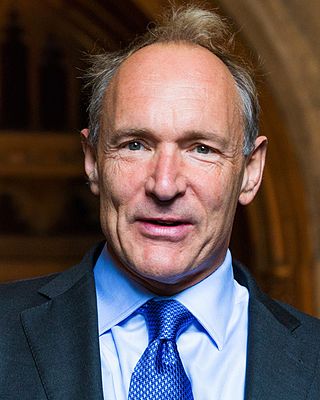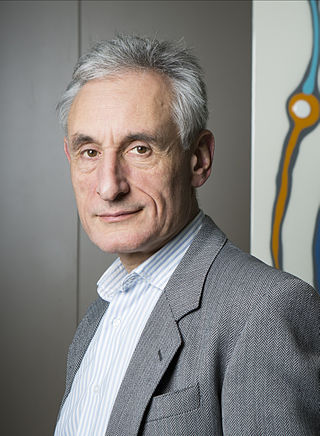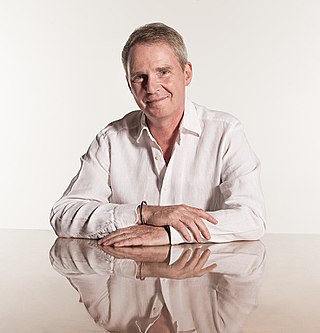
Electrical engineering is an engineering discipline concerned with the study, design, and application of equipment, devices, and systems which use electricity, electronics, and electromagnetism. It emerged as an identifiable occupation in the latter half of the 19th century after the commercialization of the electric telegraph, the telephone, and electrical power generation, distribution, and use.

Sir Timothy John Berners-Lee, also known as TimBL, is an English computer scientist best known as the inventor of the World Wide Web, the HTML markup language, the URL system, and HTTP. He is a professorial research fellow at the University of Oxford and a professor emeritus at the Massachusetts Institute of Technology (MIT).

The University of Southampton is a public research university in Southampton, England. Southampton is a founding member of the Russell Group of research-intensive universities in the United Kingdom.

The Institution of Engineering and Technology (IET) is a multidisciplinary professional engineering institution. The IET was formed in 2006 from two separate institutions: the Institution of Electrical Engineers (IEE), dating back to 1871, and the Institution of Incorporated Engineers (IIE) dating back to 1884. Its worldwide membership is currently in excess of 158,000 in 153 countries. The IET's main offices are in Savoy Place in London, England, and at Michael Faraday House in Stevenage, England.

Andrew Blake FREng, FRS, is a British scientist, former laboratory director of Microsoft Research Cambridge and Microsoft Distinguished Scientist, former director of the Alan Turing Institute, Chair of the Samsung AI Centre in Cambridge, honorary professor at the University of Cambridge, Fellow of Clare Hall, Cambridge, and a leading researcher in computer vision.
Inspec is a major indexing database of scientific and technical literature, published by the Institution of Engineering and Technology (IET), and formerly by the Institution of Electrical Engineers (IEE), one of the IET's forerunners.

Dame Wendy Hall is a British computer scientist. She is Regius Professor of Computer Science at the University of Southampton.

Vladimir (Vlad) M. Shalaev is a Distinguished Professor of Electrical and Computer Engineering and Scientific Director for Nanophotonics at Birck Nanotechnology Center, Purdue University.

Babol Noshirvani University of Technology (BNUT), sometimes also referred to as Noshirvani Institute of Technology or NIT, is a public research university and Institute of Technology in Babol, Mazandaran Province in the north of Iran, 20 km (12 mi) south of the Caspian Sea. The university is an influential center for academic research in Iran, due to which it has been consistently ranked among the top schools in the country. BNUT is currently ranked 1st among all Iranian universities according to Times Higher Education (THE) World University Rankings. THE has also ranked BNUT between 351st and 400th among world universities, 55th among the world's young universities, as well as 43rd among Asian universities.

Sir Nigel Richard Shadbolt is Principal of Jesus College, Oxford, and Professorial Research Fellow in the Department of Computer Science, University of Oxford. He is chairman of the Open Data Institute which he co-founded with Tim Berners-Lee. He is also a visiting professor in the School of Electronics and Computer Science at the University of Southampton. Shadbolt is an interdisciplinary researcher, policy expert and commentator. His research focuses on understanding how intelligent behaviour is embodied and emerges in humans, machines and, most recently, on the Web, and has made contributions to the fields of Psychology, Cognitive science, Computational neuroscience, Artificial Intelligence (AI), Computer science and the emerging field of Web science.
The IET Mountbatten Medal is awarded annually for an outstanding contribution, or contributions over a period, to the promotion of electronics or information technology and their application. The Medal was established by the National Electronics Council in 1992 and named after Louis Mountbatten, The Earl Mountbatten of Burma, Admiral of the Fleet and Governor-General of India. Since 2011, the medal has been awarded as one of the IET Achievement Medals.
Jestico + Whiles is an architectural firm and interior design practice based in London, UK. It has completed a number of high-profile cultural, diplomatic, hotel and retail projects in Europe.

Bhawani Shankar Chowdhry is a Pakistani ICT Professional and an electronics engineer. He is a Distinguished National Professor, Meritorious Professor, Emeritus Professor and former Dean of the Faculty of Electrical, Electronics, and Computer Engineering at the Mehran University of Engineering and Technology Jamashoro, Sindh, Pakistan.

Electronic engineering is a sub-discipline of electrical engineering that emerged in the early 20th century and is distinguished by the additional use of active components such as semiconductor devices to amplify and control electric current flow. Previously electrical engineering only used passive devices such as mechanical switches, resistors, inductors, and capacitors.
William Alexander Gambling FRS, FREng was a British electrical engineer.

Saraju Mohanty is an Indian-American professor of the Department of Computer Science and Engineering, and the director of the Smart Electronic Systems Laboratory, at the University of North Texas in Denton, Texas. Mohanty received a Glorious India Award – Rich and Famous NRIs of America in 2017 for his contributions to the discipline. Mohanty is a researcher in the areas of "smart electronics for smart cities/villages", "smart healthcare", "application-Specific things for efficient edge computing", and "methodologies for digital and mixed-signal hardware". He has made significant research contributions to security by design (SbD) for electronic systems, hardware-assisted security (HAS) and protection, high-level synthesis of digital signal processing (DSP) hardware, and mixed-signal integrated circuit computer-aided design and electronic design automation. Mohanty has been the editor-in-chief (EiC) of the IEEE Consumer Electronics Magazine during 2016-2021. He has held the Chair of the IEEE Computer Society's Technical Committee on Very Large Scale Integration during 2014-2018. He holds 4 US patents in the areas of his research, and has published 500 research articles and 5 books. He is ranked among top 2% faculty around the world in Computer Science and Engineering discipline as per the standardized citation metric adopted by the Public Library of Science Biology journal.

Bashir Mohammed Ali Al-Hashimi, CBE, FRS, FREng, FIEEE, FIET, FBCS is an Iraqui computer engineering researcher, academic, and higher education leader. He is Vice President and ARM Professor of Computer Engineering at King's College London in the United Kingdom. He was the co-founder and co-director of the ARM-ECS Research Centre, an industry-university collaboration partnership involving the University of Southampton and ARM. He is actively involved in promoting science and engineering for young people and regularly contributes to engineering higher education and skills national debates. He is the chair of the Engineers 2030 working group, a national campaign overseen by the National Engineering Policy Centre and led by the UK Royal Academy of Engineering. The campaign centres around accelerating change and the future workforce of engineering.

Moeness G. Amin is an Egyptian-American professor and engineer. Amin is the director of the Center for Advanced Communications and a professor in the Department of Electrical and Computer Engineering at Villanova University.
G. B. B. "Barrie" Chaplin was a British engineer and inventor, and professor emeritus at the University of Essex where he established the Department of Electrical Engineering Science in 1966. He was selected by the IET as one of its 95 inspiring engineers and technologists of the past, present, and future and he was included in an exhibition at Savoy Place.
















